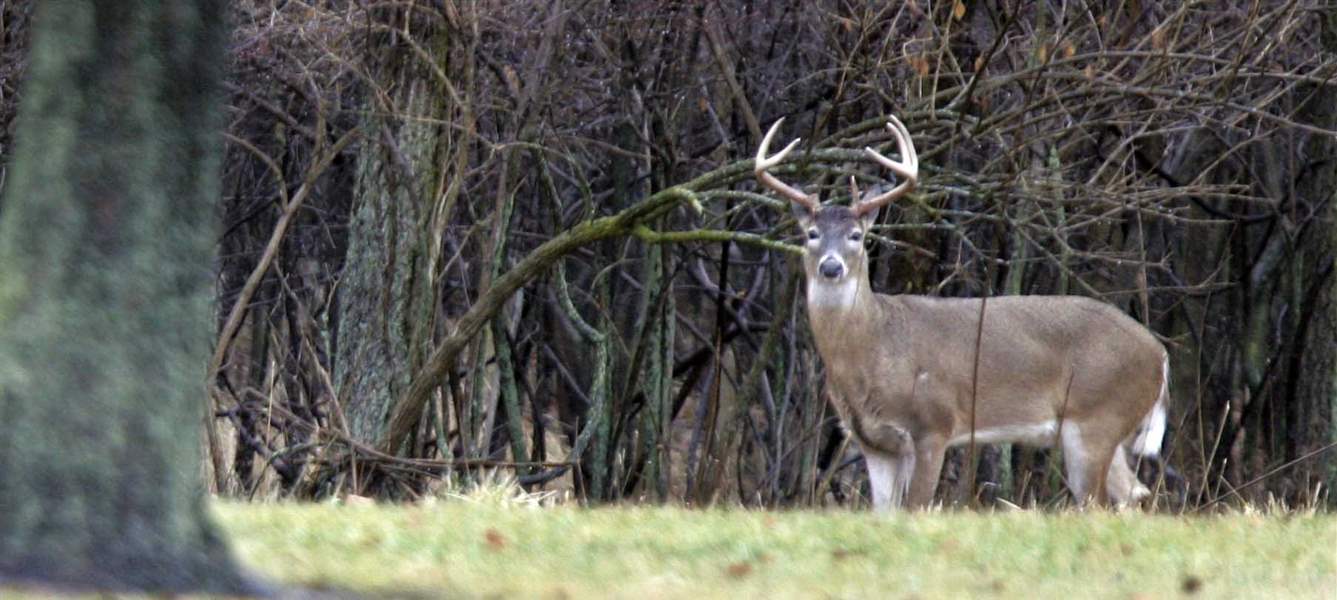
Archery hunters continue to play significant role in Ohio deer season
2/8/2018
In the 2017-18 Ohio deer season, archery hunters harvested 80,279 white-tailed deer, while the firearm and muzzleloader phases of the season produced 105,968 deer. Throughout all phases of the recently concluded Ohio season, hunters harvested 74,786 antlered deer.
The Blade
Buy This Image

In the 2017-18 Ohio deer season, archery hunters harvested 80,279 white-tailed deer, while the firearm and muzzleloader phases of the season produced 105,968 deer. Throughout all phases of the recently concluded Ohio season, hunters harvested 74,786 antlered deer.
ATHENS, Ohio — When you factor in all of the various phases, the white-tailed deer season in Ohio runs for more than four months. There’s a laundry list of variables that have to be factored into any assessment of the overall success of an event that takes place over that lengthy of a time frame.
There’s the big-picture weather over the course of the season, the snapshot weather during the brief intense hunting periods such as the gun season and the youth weekend, the fluctuations in the availability of food sources such as acorns, the timing of the corn harvest when a substantial amount of cover is removed from the landscape, hotspot outbreaks of disease threatening the wild herd, plus changes in regulations and bag limits, and the availability of permits.
Therefore, a string of footnotes is appropriately tagged onto the end of the ledger once the data for the season is compiled. With that in mind, Ohio’s 2017-18 deer season closed a half hour after sunset on Sunday with the end of the archery phase, which opened Sept. 30. Since that start, there has been a two-day, youth-only gun season, the traditional weeklong gun season, a two-day bonus gun season, and a four-day muzzleloader season.
An estimated 450,000 hunters took part in at least one of those phases of the deer season, putting in millions of hunting hours in the field. Hunters harvested 186,247 white-tailed deer during the course of the 2017-18 season. That compares to the 2016-17 harvest total of 182,169 deer.
In the continuation of a recent trend, archery hunters accounted for a significant portion of the total harvest. Archery hunters took 80,279 of the harvested deer, while the firearm and muzzleloader phases of the season produced 105,968 deer.
Mike Tonkovich, the Ohio Division of Wildlife’s deer program administrator based here in the southeastern hill country, said the 2017-18 harvest came very close to meeting the expectations of the biologists who monitor the state’s wild herd. Tonkovich said lousy weather and tough hunting conditions in one phase were offset by ideal circumstances during other periods of high hunter activity.

“For one of the first times in a while, hunters had snow to hunt over without the brutal cold weather during the bonus gun season, and that was important,” he said. “In those ideal conditions, we ended up with a real nice harvest for those two days.”
Ohio’s hunters checked 14,115 white-tailed deer during the bonus gun weekend in 2017, a huge spike over the 9,228 deer harvested in far less than ideal conditions the previous year.
“That was quite a head-scratcher when those numbers came in,” Tonkovich said.
He added that because of significant spikes and drops in harvest trends during the course of the full season and from one year to the next, more accurate assessments of the status of the herd and the effectiveness of the regulation set come from examining a larger amount of data, such as three-year pictures.
“At the end of the day, it makes sense to look at the current year and the previous two years, rather than simply comparing this year to last year,” he said. “When you bring in three years worth of numbers, it tends to take the top off of those peaks and level out the valleys. That just provides us with a better picture of where we are.”
The expressed goal of Ohio’s Deer Management Program is to provide a deer population that not only maximizes the recreational opportunities, but also limits the deer conflicts with landowners and deer-car crashes. During the past three years, Ohio’s deer hunting regulations have been focused on allowing for moderate growth of the wild herd in most areas of the state, through reduced harvest limits and less harvest of antlerless deer.
METROPARKS CULL: Sharpshooters from the USDA completed their role in the white-tailed deer cull in January, assisting Metroparks rangers in removing 240 deer from six park properties. The culled deer were processed locally, and Metroparks Toledo donated 11,284 pounds of ground venison to local food pantries. The culling permit the Metroparks received from the Ohio Department of Natural Resources had allowed for the removal of up to 285 deer from six park and preserve properties. While most of the recently culled animals came from Side Cut & Fallen Timbers Battlefield (106), Swan Creek (64), and Oak Openings (50), just one deer was culled from Middlegrounds. Metroparks officials had observed significant numbers of deer on the Middlegrounds property and chronicled damage to the vegetation there from overbrowsing, but on the night the culling at that site was planned, the deer had moved elsewhere and just were not present at Middlegrounds, a spokesman for the park system said. The deer that frequent Middlegrounds use the river and the nearby railroad as travel corridors and migrate back and forth throughout the area.
OTTAWA HILLS: The controlled archery hunt concluded recently with 54 deer being removed from seven sites in the village. Twenty hunters took part in the hunt, with 45 does and nine bucks harvested. Thirteen of the deer were donated to local entities that provide meals for the needy.
WHITETAILS UNLIMITED SURVEY: Ohio hunters are encouraged to voice their opinions on hunting habits, traditions, and expectations in a survey being conducted by Whitetails Unlimited’s Ohio membership and Fin Feather Fur Outfitters, a leading outdoor retailer with five locations in the Buckeye State. The organization reports that Ohio has seen a drop of 30,000 in its deer hunting ranks, and the survey seeks to pinpoint the cause of that reduction and what needs to be done to reverse the trend. The survey is free and available at the whitetailsunlimited.com website. Whitetails Unlimited has more than 40 chapters and 12,500 members in Ohio.
Contact Blade outdoors editor Matt Markey at: mmarkey@theblade.com or 419-724-6068.